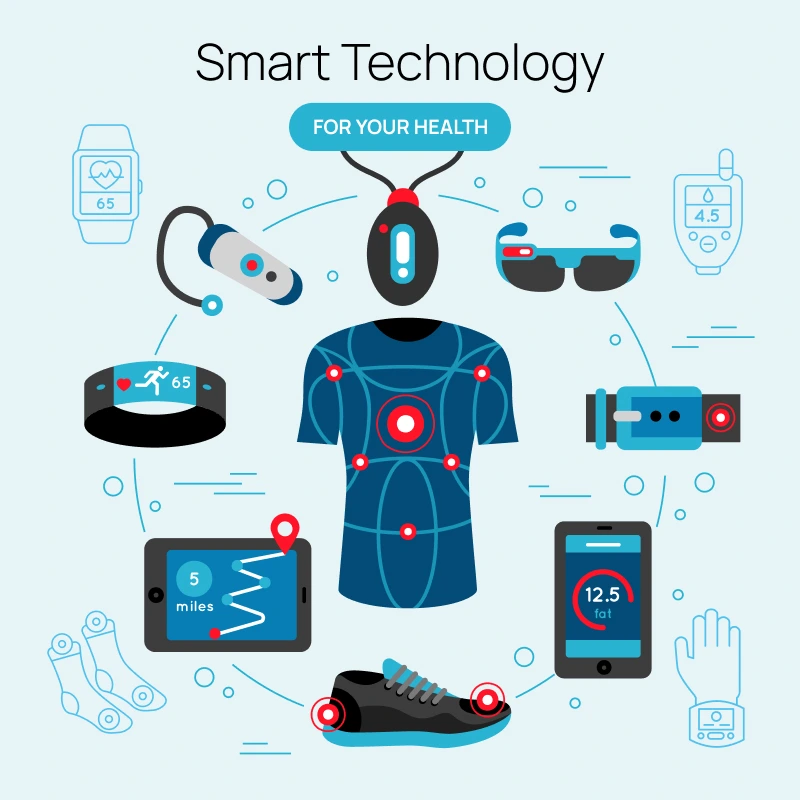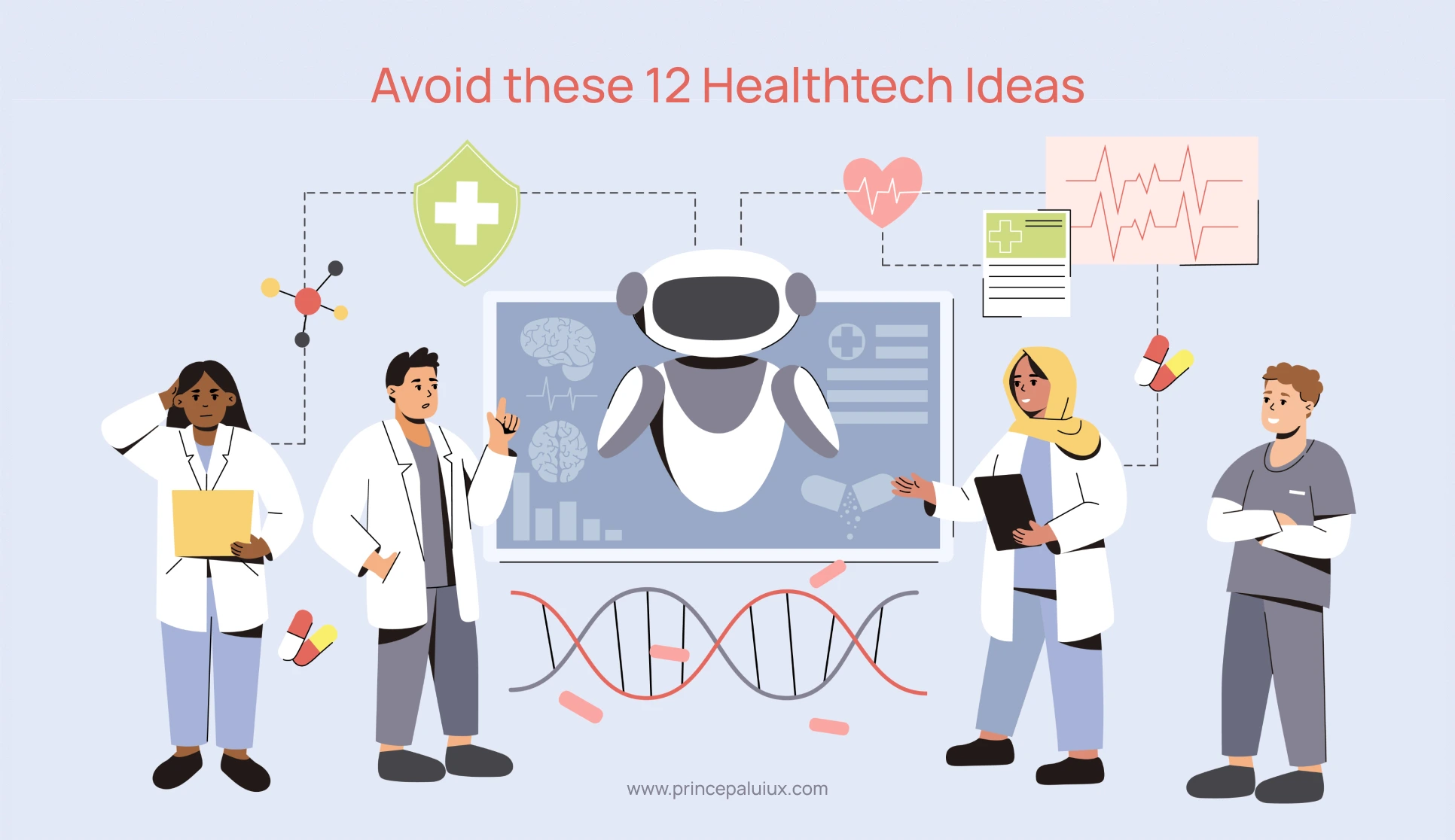Let’s be real. If you’re building a healthtech idea for your startup, you’re already in one of the most demanding, slowest, and most regulated industries out there.
And yet, some ideas still manage to make it even harder.
After 12+ years of working with health tech startups—as a builder, backer, and frequent “please help us get unstuck” consultant—I’ve seen brilliant founders walk straight into beautifully wrapped traps. I call them Tarpit Ideas.
On the surface, they look amazing. Huge TAM. Big promises. AI, wearables, blockchain — what’s not to love?
But once you get going, you realize: you’re sinking. Fast.
Table of Contents
- 1. Personalized Health Dashboards
- 2. General-Purpose AI Diagnostics
- 3. Blockchain for Medical Records
- 4. Consumer Genetic Risk Scoring
- 5. AI for Mental Health Support
- 6. Wearable Preventive Health
- 7. Virtual Reality for Patient Therapy
- 8. Symptom Checkers for Consumers
- 9. B2C Subscription Wellness Apps
- 10. Digital Therapeutics Without Reimbursement
- 12. Smart Toilets and “Lab-at-Home” Devices
Avoid common traps in healthtech. Discover twelve startup ideas that seem brilliant at first — but can quietly sink your startup before it scales.
1. Personalized Health Dashboards

“All your health data in one place!”
Sounds neat — until you realize that the average person doesn’t care enough to log in unless they’re managing a chronic illness.
Pulling in data from wearables, labs, and EHRs is a technical and legal nightmare. And even if you manage to pull it off? No one wants to pay for it.
(Remember Google Health? Microsoft HealthVault? Exactly.)
2. General-Purpose AI Diagnostics
“Our AI will replace doctors!”
In theory: genius. In practice? Wildly naïve.
AI works best when it’s laser-focused on radiology, dermatology, and pathology. Try going broad, and suddenly you’re facing specialty-specific data sets, regulatory hurdles, and a trust gap the size of a canyon.
IBM’s Watson Health blew billions trying to make this work. Spoiler: it didn’t.
3. Blockchain for Medical Records
“Decentralized healthcare!”
Look, the dream of giving patients control over their records is noble. But here’s the reality: hospitals still hold the keys.
Interoperability is chaos. Blockchain adds another layer of complexity without solving the trust, access, or usability problems that matter.
Remember Medicalchain? BurstIQ? Didn’t think so.
4. Consumer Genetic Risk Scoring
“Predict your health future with DNA!”
This one’s slick on paper. But most people either (a) don’t want to know, or (b) don’t know what to do once they do know.
Low engagement, vague insights, and sky-high customer acquisition costs make this a leaky bucket. Even 23andMe had to pivot — hard — into drug discovery.
5. AI for Mental Health Support
“Therapy bots for everyone!”
The idea? Scalable. The reality? Fragile.
When someone’s in real distress, scripted empathy just doesn’t cut it. Users lose trust fast, and many of these startups quietly shift to human-led models within a year.
Mental health deserves more than good intentions and a chatbot with canned responses.
6. Wearable Preventive Health
“Catch illness early with wearable tech!”
Wearables give you data. But data ≠ decisions.
Doctors don’t trust it, patients get bored, and insurers don’t pay for it. Even Apple, with all its resources, still struggles to prove clinical value beyond counting steps.
Add fierce competition from giants? You’re swimming with sharks.
Healthtech Idea that can work – Wearable Devices
CGMs (like Dexcom and Abbott) and devices like iRhythm — they’re not just exceptions, they’re proof that when wearables focus on specific, high-stakes clinical use cases, they can thrive.

The trap isn’t wearables as a whole — it’s the preventive wellness wearables aimed at the general population, trying to drive behavior change with vague insights like “your sleep score was 71.”
What is CGM (Continuous Glucose Monitors)?
They are wearable devices that track blood sugar (glucose) levels continuously throughout the day and night, typically using a small sensor placed just under the skin, often on the arm or abdomen.
Instead of pricking your finger multiple times a day (like traditional blood glucose testing), CGMs automatically measure and update glucose readings every few minutes.
Some well-known CGM brands are:
- Dexcom (G6, G7)
- Abbott’s FreeStyle Libre
- Medtronic Guardian Connect
They’re life-changing for people with diabetes, helping them manage their blood sugar more proactively, and increasingly, some health enthusiasts without diabetes are using CGMs to monitor metabolic health too.
CGMs work because:
- The data is actionable
- The condition (diabetes) is urgent and ongoing
- Payers and providers have a financial incentive to care
- And most importantly, the user has skin in the game
So yes, the bio-wearables space is growing fast, but success tends to follow clinical specificity, clear ROI, and real health outcomes, not just novelty or quantified-self vibes.
Wearable Blood Pressure monitors are much needed, and that market is ready to explode for the right clinical-grade device. Additional areas include wearables that measure hydration and those that measure stress levels. CGMs are now being upgraded to measure ketones and other metabolites as well.
Yes — that’s largely true, and you’re tapping into where clinical wearables are heading. Here’s a breakdown:
✅ Wearable Blood Pressure Monitors
Yes — the market is hot and underserved.
Most current solutions are either bulky, like cuff-based devices, or not clinically validated when they are cuffless. A truly accurate, FDA-cleared wearable for continuous blood pressure monitoring would be a game-changer for hypertension, one of the most common chronic conditions globally.
Startups and giants, like Apple and Samsung, are racing toward this. Once someone cracks clinical-grade reliability? Boom.
✅ Hydration Tracking Wearables
Much needed in sports, elderly care, and critical care — but tricky.
Hydration is notoriously hard to track. Most current devices are estimations based on bioimpedance or sweat analysis, and haven’t reached medical-grade reliability. The market is interested, especially for aging populations and athletes, but it still needs a breakout product with real validation.
✅ Stress Monitoring Wearables
This is already a feature in devices like Fitbit, Garmin, and WHOOP — using heart rate variability (HRV), skin conductance, and sleep quality as proxies for stress.
The demand is there, especially in areas such as wellness, mental health, and workplace productivity. However, accuracy and actionability are still concerns. A wearable that doesn’t just say “you’re stressed” but helps you intervene effectively could lead the next wave.
✅ CGMs Measuring Ketones and Other Metabolites
Absolutely — next-gen CGMs are being developed to track more than glucose, including:
- Ketones (for keto dieters, metabolic monitoring, and diabetes)
- Lactate (for athletes)
- Alcohol (yes, even this is being explored). Companies like Levels, Supersapiens, and Abbott are exploring multi-analyte sensors. The “metabolic health” wearables movement is evolving fast, and non-invasive chemical sensing is one of the holy grails.
7. Virtual Reality for Patient Therapy
“VR for pain management, phobia treatment, rehab!”
The science is promising, but the hardware friction is real. Expensive headsets, limited content, and a learning curve most patients (and clinicians) don’t want to climb. Add in hygiene concerns in clinics? Adoption stalls fast.
8. Symptom Checkers for Consumers
“AI triage from your phone!”
They’re everywhere, yet very few drive outcomes. Liability risk is high, user trust is low, and most people still prefer to talk to a real person when they’re sick. Plus, they often get lumped into the “WebMD anxiety spiral” category.
9. B2C Subscription Wellness Apps
“Personalized coaching, meditation, supplements!”
Low barrier to entry, but even lower retention. People start with good intentions and churn within months. If you’re not Noom, Headspace, or Calm, you’re spending more on marketing than you’re making.
10. Digital Therapeutics Without Reimbursement
“App-based treatment instead of meds!”
Sounds game-changing. But without FDA approval and insurance reimbursement, it’s a dead end. Even with approval, doctors are slow to adopt, and patients won’t pay out of pocket for long-term use.
12. Smart Toilets and “Lab-at-Home” Devices
“Get health insights from your daily routine!”
Fascinating idea, sure. But between user privacy fears, behavior changes, and expensive hardware, the path to adoption is filled with resistance. It’s like selling a medical device for the most awkward room in the house.
Strange, but True Healthcare Insights
Gen Z Is Diagnosing Themselves With AI — and It’s Making Them Anxious
Gen Z (and honestly, a good chunk of Millennials, too) are increasingly turning to GenAI tools like ChatGPT for basic self-diagnosis. It’s fast, free, and doesn’t judge. But the problem?
It’s not trained to care — only to predict.
While it can summarize WebMD, it lacks nuance, context, and medical accountability. The result? People either downplay something serious or spiral into unnecessary fear. And the more accessible diagnostic data becomes, the more people are caught in a “worried well” loop:
“I don’t feel sick, but my wearable says my HRV dropped by 6 points and Google says that could mean stress or a heart issue or inflammation or… something. Should I get tested? Should I fast? Should I biohack?”
We’re unintentionally turning people into quantified hypochondriacs. More tests. More supplements. More stress.
And ironically, while tech aims to empower, it often does the opposite, replacing peace of mind with a dashboard full of question marks.
This doesn’t mean tech is bad — just that more data ≠ better health.
We need to:
- Design for emotional clarity, not just information access
- Help people understand what not to worry about
- Prioritize actionability, not just measurement
- Design AI with empathy built in — not just confidence scores
Let’s be clear
These ideas aren’t bad. They’re just insanely hard to execute, harder to monetize, and often ahead of their time.
In healthtech, the challenge isn’t just solving big problems — it’s picking the right ones to solve. Problems where user behavior, regulations, and business models align. Where you can build trust, deliver value, and grow without sinking into complexity quicksand.
So, before you fall in love with an idea that sounds amazing in a pitch deck…
Ask yourself:
Is this a breakthrough — or a beautifully disguised tarpit?
